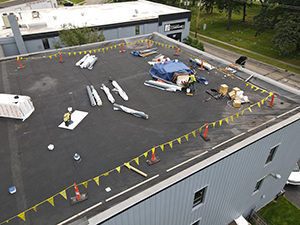
Commercial building owners and facility managers in Northern Idaho face a critical decision when it comes to selecting the best roofing system for their properties. With so many materials on the market, it’s important to choose one that balances performance, efficiency, and value. TPO (Thermoplastic Polyolefin) roofing has quickly become a top choice for commercial applications—offering outstanding durability, energy savings, and long-term cost efficiency. In this article, we explore the key benefits of TPO roofing and why a TPO roof may be the best decision in the Northern Idaho region.
If you’re looking to lower operating costs and extend the lifespan of your roof, TPO could be the smart solution your building needs.
Call Flag Ship Foam & Coatings in Coeur d’Alene today at 208-946-3031 to schedule your TPO roofing consultation.
Why TPO Roofing Outperforms Traditional Options
TPO roofing systems represent the ideal balance of performance and value for commercial applications in Northern Idaho. This single-ply membrane combines the best attributes of PVC and EPDM systems while eliminating their respective drawbacks. Research shows that properly installed TPO roofing can last 20-30 years while requiring minimal maintenance, even in challenging climate conditions.
The average TPO roof installation ranges from $5 to $9 per square foot, depending on the specifics of your project. Despite the upfront cost, the return on investment is substantial. TPO can cut energy use by up to 30% compared to traditional dark roof surfaces. For a 10,000-square-foot commercial building in Coeur d’Alene, that means thousands in annual utility savings—plus lower maintenance costs over time.
Engineered for Idaho’s Demanding Climate

Northern Idaho presents unique roofing challenges with its cold winters, hot summers, and significant seasonal precipitation. TPO roofing excels in these conditions due to several key features:
- Exceptional heat-welded seams that eliminate leakage points
- Superior resistance to UV radiation and ozone degradation
- Remarkable flexibility, allowing for expansion and contraction during temperature fluctuations
- Outstanding puncture and tear resistance
- Excellent chemical resistance against acid rain and common rooftop pollutants
- Impressive wind uplift ratings suitable for Coeur d’Alene’s weather patterns
The Energy-Efficient Roofing Solution
In today’s cost-conscious business environment, energy efficiency isn’t just environmentally responsible—it’s financially essential. TPO roofing delivers impressive efficiency benefits:
- Highly reflective white surface reflects up to 87% of solar radiation
- Reduces cooling costs by 10-30% during summer months
- Maintains reflectivity longer than other white roofing materials
- Helps minimize urban heat island effect
- Contributes to ENERGY STAR and LEED certification requirements
- Reduces carbon footprint through decreased energy consumption
Long-Term Cost Advantages
The financial benefits of TPO roofing extend throughout the system’s lifespan:
- Reduced maintenance requirements compared to traditional built-up roofing
- Lower lifecycle costs than comparable commercial roofing systems
- Extended roof lifespan through superior weathering characteristics
- Potential insurance premium reductions due to improved fire ratings
- Recyclable materials that can reduce disposal costs at end of service life
- Lightweight system that places less stress on building structure
TPO Roofing Experts
The evidence clearly shows that TPO roofing represents not merely a roofing solution but a strategic investment in your commercial property’s performance and value. By choosing TPO, building owners secure decades of protection while significantly reducing energy consumption and maintenance expenses.
Professional installation is critical to realizing the full benefits of TPO roofing. Flag Ship’s certified technicians bring specialized heat-welding equipment and extensive experience to ensure your system delivers maximum performance throughout its extended lifespan.
Discover how a TPO roof can transform your commercial property’s efficiency and durability. Call Flag Ship Foam & Coatings in Coeur d’Alene, ID today at 208-946-3031 and schedule your comprehensive consultation.
FAQ
How long does TPO roofing typically last?
With professional installation and routine maintenance, TPO roofing systems regularly last 20-30 years in commercial applications. The thickness of the membrane (45, 60, or 90 mil) affects longevity, with thicker membranes generally providing longer service life. Regular inspections and prompt repairs of any damage can extend the system’s lifespan considerably.
Is TPO roofing suitable for Idaho’s weather conditions?
Absolutely. TPO roofing excels in Idaho’s variable climate. Its exceptional flexibility allows it to expand and contract with temperature fluctuations without cracking or splitting. The heat-welded seams create a monolithic surface that prevents water infiltration from rain and snowmelt, while the reflective surface reduces heat absorption during summer months.
How does TPO compare to other commercial roofing options in terms of cost?
TPO offers excellent value compared to other commercial systems. Initial installation costs are typically lower than PVC while offering similar performance benefits. While slightly more expensive than EPDM initially, TPO’s energy efficiency often delivers a faster return on investment through reduced cooling costs. The total lifecycle cost of TPO is generally 15-25% lower than traditional built-up roofing systems.
Can TPO roofing be installed over my existing commercial roof?
In many cases, yes. TPO can often be installed over existing roof systems if they’re structurally sound and relatively dry. This “recover” approach eliminates tear-off costs and minimizes business disruption. A thorough inspection by Flag Ship’s experts can determine if your roof is a candidate for TPO overlay installation.
What maintenance does TPO roofing require?
TPO roofing requires minimal maintenance compared to many alternative systems. Best practices include bi-annual professional inspections (typically spring and fall), keeping the roof free of debris, ensuring drainage systems remain clear, and promptly addressing any punctures or damage. This simple maintenance regimen typically costs 40-60% less than traditional built-up roofing maintenance programs.